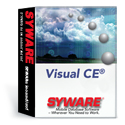Visual CE® FAQ

V5-a)
How can I upgrade from one edition (Personal, Professional, Enterprise
or MobileSuite) to another?
Our current policy is that you can upgrade one edition to a higher
edition by just paying the difference the price of the edition
you want minus whatever you paid for the edition you have. For
example, if you paid $129 for your Personal Edition, you can upgrade
to the Pro Edition for just $270 ($399 minus $129). For more details,
visit our upgrade information page.
V5-b)
How do I distribute my forms?
Starting in Visual CE 9.0, you can use the runtime wizard (FILE | CREATE DISTIBUTION FILES) to create an installer for your application. After the wizard creates the installer, copy the installer files onto a floppy disk or CD. This is what you distribute to your users. It contains all the redistributable components of Visual CE. Your users will run SETUP.EXE from this disk to install your application.
If you have an older version of Visual CE, do the following:
The older Pro Edition and Enterprise Edition come with a redistributable
runtime system. Run the self extracting zip file by selecting
START | PROGRAMS | VISUAL CE | RUNTIME. This will create a folder
in a location you specify and copy some files into this folder.
Copy the contents of this folder onto a floppy disk or CD. This
is your RUNTIME diskette. The RUNTIME diskette is contains the redistributable components
of Visual CE®. If, on a desktop machine, you run SETUP.EXE from the RUNTIME diskette
while a handheld is attached, it will install the Expense form,
the Visual CE runtime modules, and the desktop synchronization
modules. You can modify the RUNTIME disk to install your form
instead, just follow the instructions in the file "Visual
CE.lod" (it is a text file).
V5-c)
Can multiple Windows CE devices synchronize to the same table? How?
You
can easily configure Visual CE's synchronizer so multiple Windows
CE devices can synchronize to the same table. To do this:
(1)
Create your table, a form over that table, and set up synchronization
for that table as you normally would.
(2)
Assign a unique name to each handheld (on a P/PC: START | SETTINGS
| SYSTEM | ABOUT | DEVICE ID | DEVICE NAME, on a H/PC: START |
SETTINGS | CONTROL PANEL | COMMUNICATIONS | DEVICE NAME)
(3)
Go to the synchronization setting (Visual CE's FILE | SYNCHRONIZE),
double click the name of the table, and check the "Multiple
handhelds synchronizing to the same table" checkbox.
Although
it is not neccessary, you might consider "cleaning out"
your tables immediately after you turn on the "Multiple handhelds
synchronizing to the same table" checkbox. To do this, remove
all the records on the handheld and set to OID to blank (or zero)
for all the records on the desktop.
V5-d)
In addition to my form, I want my runtime disk to also install a
Pocket Access database (a .CDB file). Everytime I drag the .cdb
file to my desktop, ActiveSync Converts it to a .MDB file. How can
I keep ActiveSync from converting the file?
Using ActiveSync on the desktop, change the file extension from
.CDB to .CD. Then, drag the file to the desktop. It should come
over without being converted. Once the file is on the desktop,
change the extension back to .CDB (don't forget to do this both
on the desktop and the handheld).
V5-e)
I want my runtime disk to also install an Access database on the
desktop (a .MDB file). How do I do that?
Starting in Visual CE 9.0, you can use the runtime wizard (FILE | CREATE DISTIBUTION FILES) to create an installer for your application. The wizard gives you the option to include the .MDB file along with the rest of the intaller.
If you have an older version of Visual CE, do the following:
If your desktop database is aIf
your desktop database is a .MDB file, the installer will look
for the. MDB file on the installation disk. If it finds it, it
will copy it to the location designated as the "Desktop Database" in Visual CE's FILE | SYNCHRONIZE settings.
